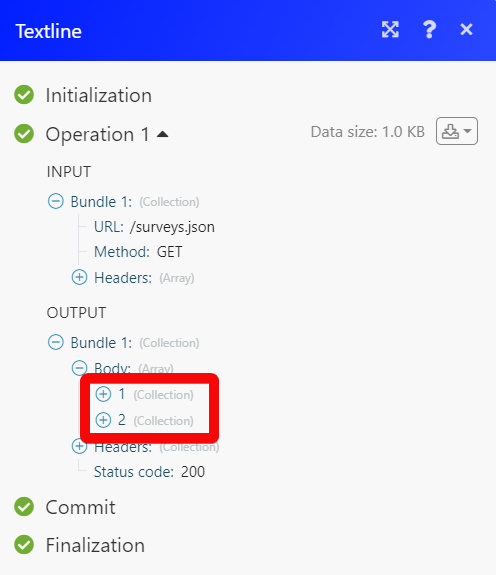The Textline modules allow you to monitor, create, update, send, retrieve, list, and delete announcements, agents, conversations, and customers in your Textline account.
Prerequisites
-
A Textline account – you can create a Textline account at textline.com/.
![[Note]](https://docs.boost.space/wp-content/themes/bsdocs/docs-parser/HTML/css/image/note.png) |
Note |
|---|---|
|
The module dialog fields that are displayed in bold (in the Boost.space Integrator scenario, not in this documentation article) are mandatory! |
To connect your Textline account to Boost.space Integrator you need to obtain an access token from your Textline account and insert it in the Create a connection dialog in the Boost.space Integrator module.
1. Log in to your Textline account.
2. Click Settings > Tools & Integrations > Developer API.
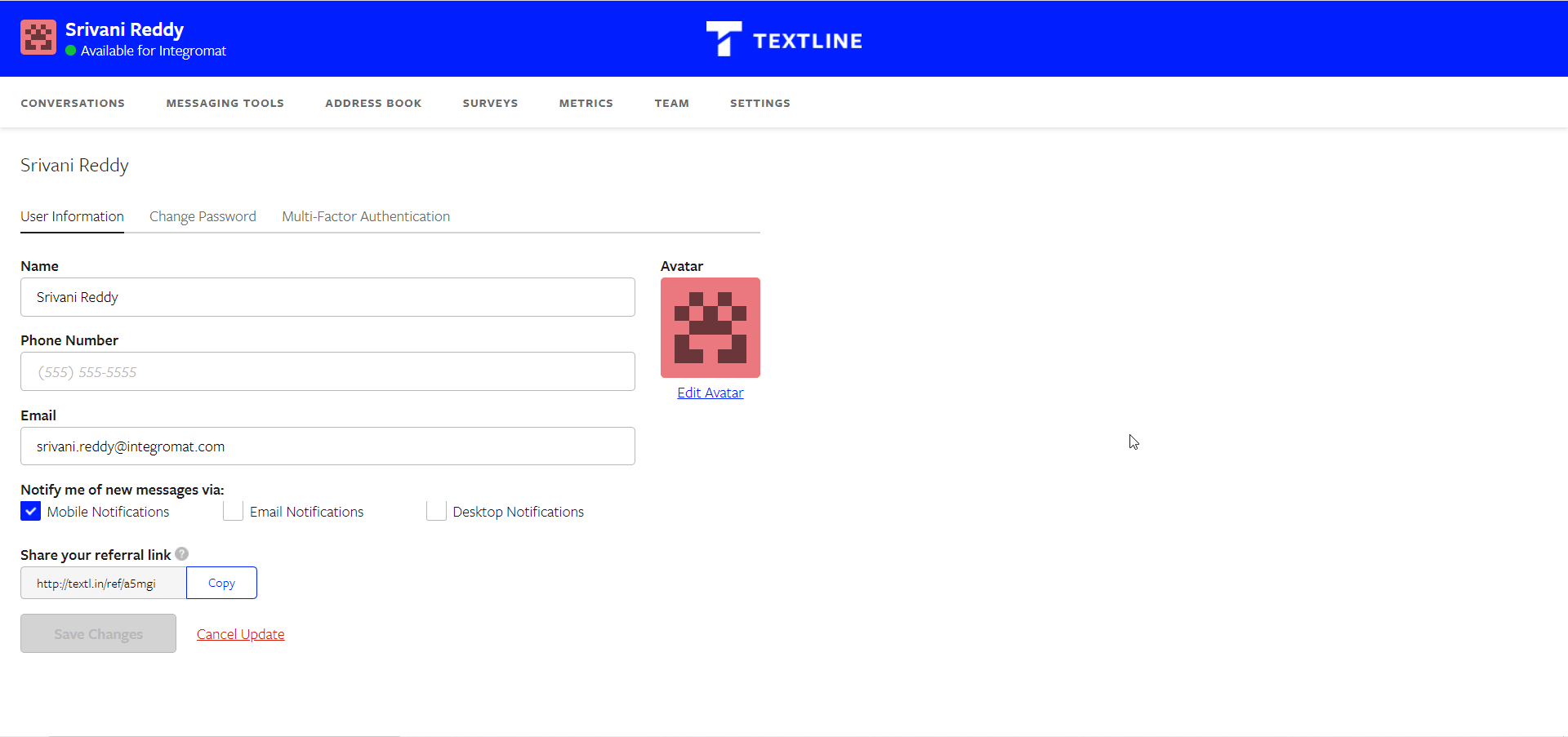
3. Copy theAccess Token to your clipboard.
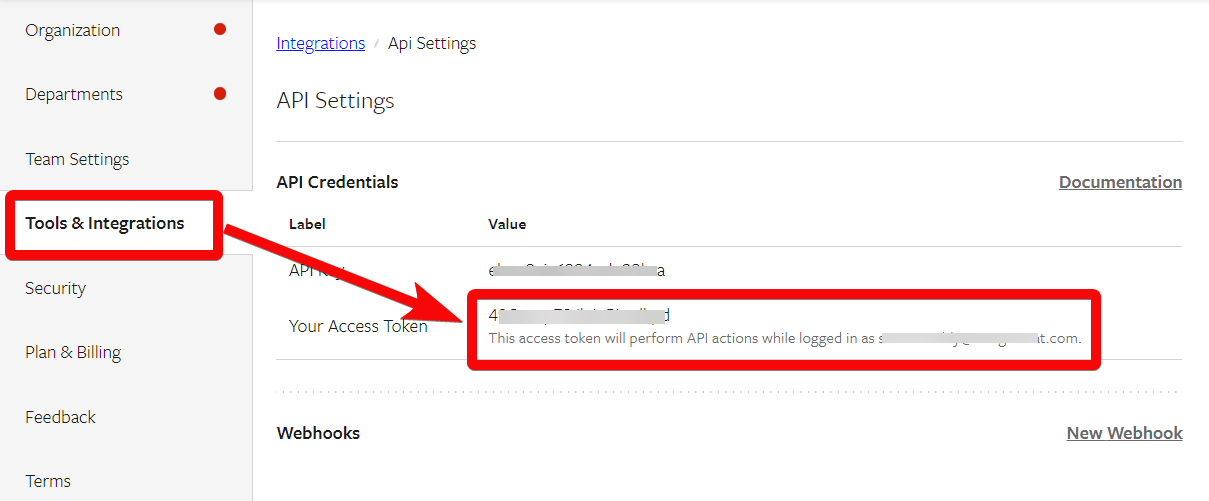
4. Go to Boost.space Integrator and open the Textline module’s Create a connection dialog.
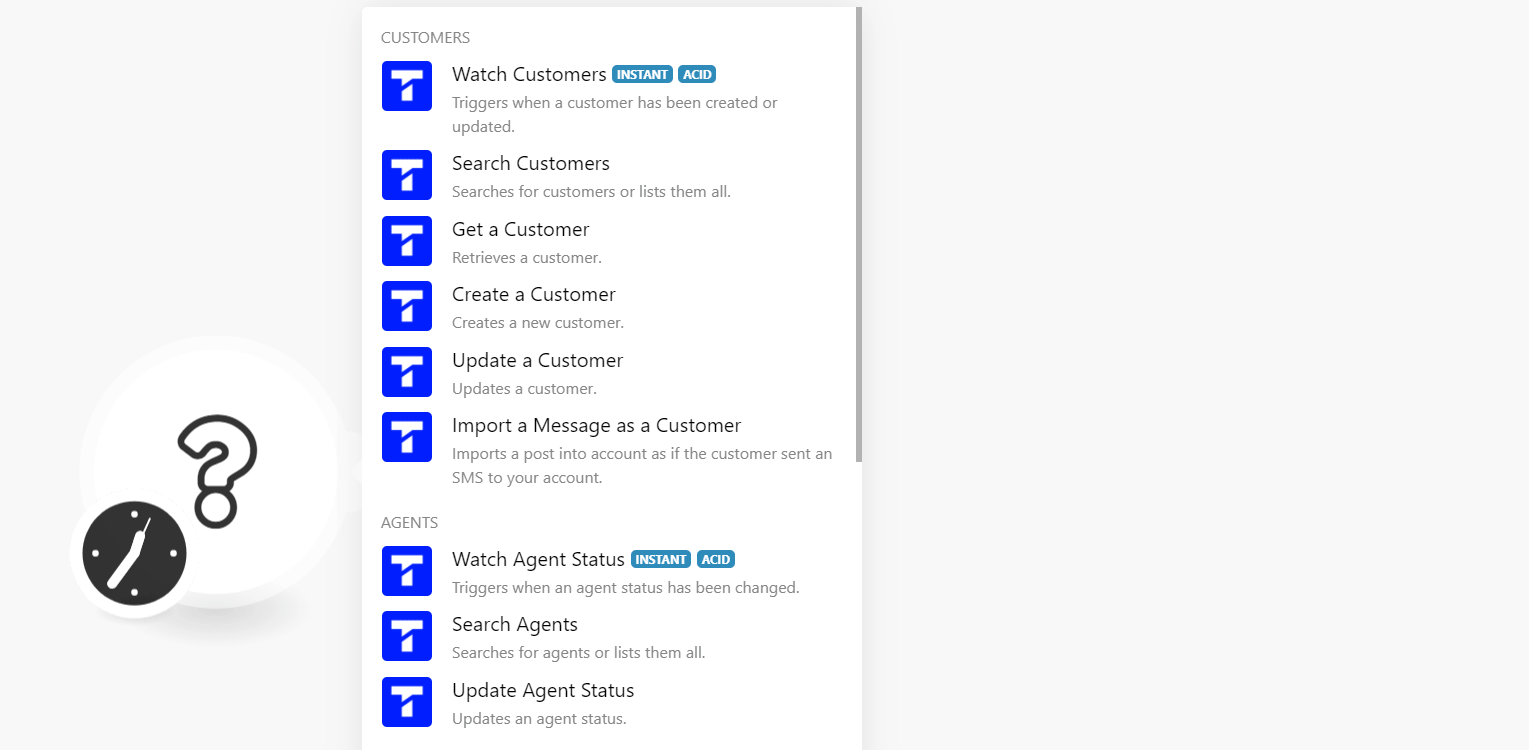
5. In the Connection name field, enter a name for the connection.
6. In the Access Token field, enter the token copied in step 4, and click Continue.
The connection has been established.
See Setting Up Textline Webhooks to add the webhooks in your Textline account.
Triggers when a customer has been created or updated.
|
Webhook Name |
Enter a name for the webhook. |
|
Connection |
Searches for customers or lists them all.
|
Connection |
|
|
Search |
Enter (map) a keyword or phrase to search the customers that match the specified criteria. |
|
Limit |
Set the maximum number of customers Boost.space Integrator will return during one execution cycle. |
Retrieves a customer.
|
Connection |
|
|
Customer UUID |
Select or map the Customer UUID whose details you want to retrieve. |
Creates a new customer.
|
Connection |
||||
|
Phone Number |
Select or map the phone number of the customer. For example, (222) 222-2222. |
|||
|
|
Enter (map) the email address of the customer. |
|||
|
Name |
Enter (map) the customer name. |
|||
|
Notes |
Enter (map) the additional information about the customer. |
|||
|
Tags |
Add the tags for the customer. |
|||
|
Custom Fields |
Add the custom fields and their values. For example, address.
|
Updates a customer.
|
Connection |
||||
|
Customer UUID |
Select or map the Customer UUID whose details you want to update. For example, (222) 222-2222. |
|||
|
|
Enter (map) the email address of the customer. |
|||
|
Name |
Enter (map) the customer name. |
|||
|
Notes |
Enter (map) the additional information about the customer. |
|||
|
Tags |
Add the tags for the customer. |
|||
|
Archived |
Select whether the customer is archived. |
|||
|
Custom Fields |
Add the custom fields and their values. For example, address.
|
Imports a post into your account as if the customer sent an SMS to your account.
|
Connection |
|
|
Phone Number |
Select or map the phone number of the contact whose conversation message you want to retrieve. For example, (222) 222-2222 |
|
Body |
Enter (map) the message text. |
|
Group UUID |
Select or map the Group UUID to which the contact belongs. |
See Setting Up Textline Webhooks to add the webhooks in your Textline account.
Triggers when an agent’s status has been changed.
|
Webhook Name |
Enter a name for the webhook. |
|
Connection |
Searches for agents or lists them all.
|
Connection |
|
|
Agent UUID |
Select or map the Agent UUID whose details you want to list. |
|
|
Enter (map) the email address to list the agents that match the specified email address. |
|
Limit |
Set the maximum number of agents Boost.space Integrator should return during one execution cycle. |
Updates an agent’s status.
|
Connection |
|
|
Agent UUID |
Select or map the Agent UUID whose status you want to update. |
|
Available |
Select the checkbox to make the agent status to available. |
See Setting Up Textline Webhooks to add the webhooks in your Textline account.
Triggers when a message from a customer has been received.
|
Webhook Name |
Enter a name for the webhook. |
|
Connection |
Triggers when an outbound message has been sent.
|
Webhook Name |
Enter a name for the webhook. |
|
Connection |
Triggers when a conversation status has been changed.
|
Webhook Name |
Enter a name for the webhook. |
|
Connection |
Triggers when a whisper from an agent has been received.
|
Webhook Name |
Enter a name for the webhook. |
|
Connection |
Sends an outbound message to a phone number.
|
Connection |
|
|
Phone Number |
Enter (map) the phone number to which you want to send the message. |
|
Body |
Enter (map) the message text you want to send. |
|
Resolve |
Select the checkbox to resolve the message text after sending the message. |
|
Group UUID |
Select or map the Group UUID of the department from which you want to retrieve conversations. If you are not using a department UUID then the message will go out on your first department. |
|
Attachments |
Add the URL addresses of the attachments which you want to attach to the message. |
Sends an outbound message to a conversation.
|
Connection |
|
|
Conversation UUID |
Select or map the Conversation UUID you want to message. |
|
Body |
Enter (map) the message text you want to send. |
|
Resolve |
Select the checkbox to resolve the message text after sending the message. |
|
Attachments |
Add the URL addresses of the attachments which you want to attach to the message. |
Sends a new survey.
|
Connection |
|
|
Survey UUID |
Select or map the Survey UUID you want to send. |
|
Selection Type |
Select or map the option to send the survey:
|
|
Tags |
Add the survey tags separated by a comma. |
|
Phone Numbers |
Add the phone number of the contacts to whom you want to send the survey. |
|
Saved Search UUID |
Enter (map) the saved Search UUID to whom you want to send the survey. |
Sends an announcement to a group of contacts.
|
Connection |
|
|
Selection Type |
Select or map the option to send the announcement:
|
|
Tags |
Add the tags of the contact separated by a comma to send the announcement that matches the specified tag. |
|
Phone Numbers |
Add the phone number of the contacts to whom you want to send the announcement. |
|
Group UUID |
Select or map the Group UUID to whose contact you want to send the announcement. |
|
Comment Body |
Enter (map) the announcement text. |
|
Title |
Enter (map) a title for the announcement. |
|
Resolve on Send |
A true/false value to set whether the conversation opened after an announcement is sent should be resolved. This does not affect conversations open before the announcement is sent. |
|
Assignment Target UUID |
Enter (map) the UUID of the agent that should be assigned any conversations created (and opened) as a result of the announcement. |
|
Reply Window Value |
Enter (map) time in seconds after which any message sent in by the contact should be considered a reply to the announcement. |
|
Reply Assignment Target UUID |
Select or map the UUID of the agent that should be assigned any conversations opened as a result of a contact replying to the announcement. |
Performs an arbitrary authorized API call.
|
Connection |
||||
|
URL |
Enter a path relative to
|
|||
|
Method |
Select the HTTP method you want to use: GET to retrieve information for an entry. POST to create a new entry. PUT to update/replace an existing entry. PATCH to make a partial entry update. DELETE to delete an entry. |
|||
|
Headers |
Enter the desired request headers. You don’t have to add authorization headers; we already did that for you. |
|||
|
Query String |
Enter the request query string. |
|||
|
Body |
Enter the body content for your API call. |
1. Open any Watch module, establish a connection and copy the URL address to your clipboard. Click OKand save the trigger.
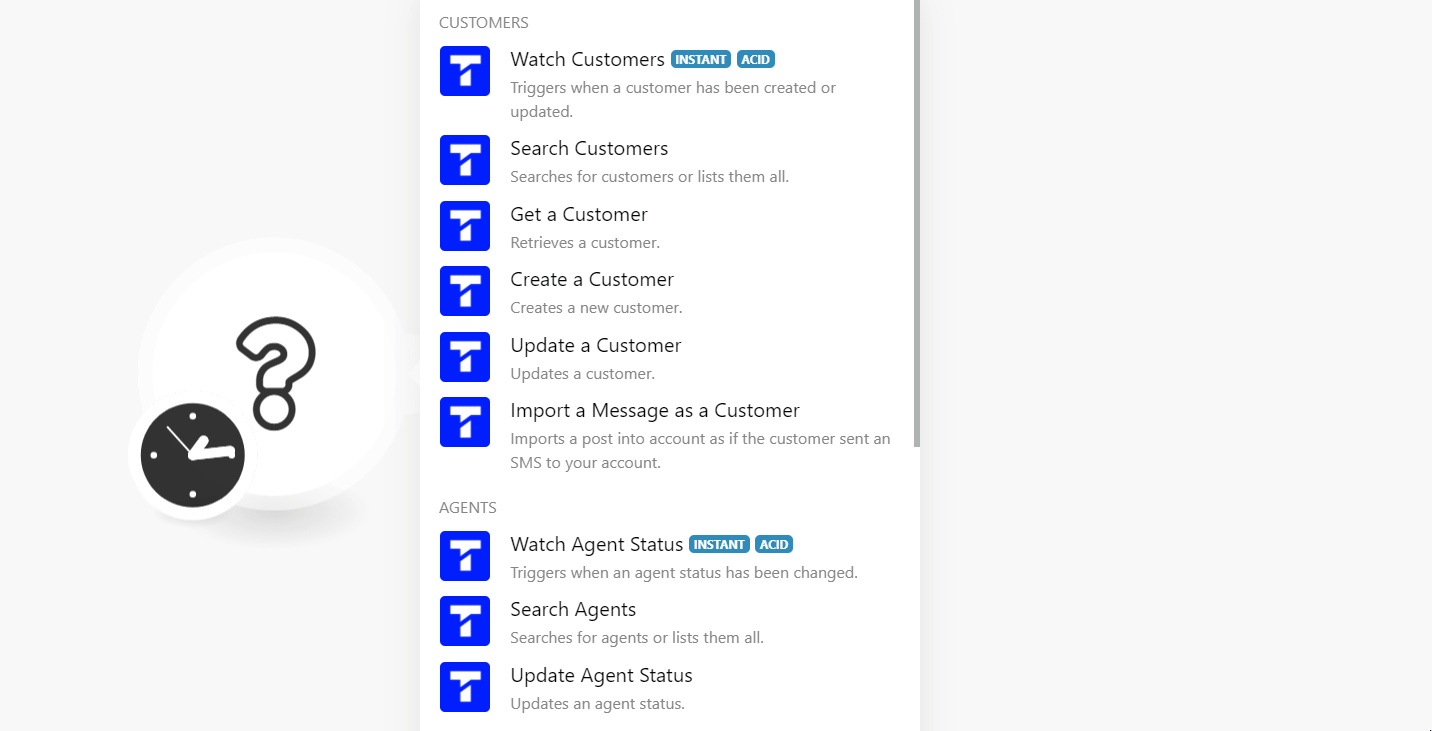
2. Log in to your Textline account.
3. Click Settings > Tools & Integrations > Developer API > New Webhook.
4. Enter the following details:
-
Type: Select the type of event you want to watch
-
URL: Enter (map) the URL address copied in step 1
-
Method: Select the HTTPS request method.
5. Click Save.
The webhook is successfully set up. Go back to Boost.space Integrator and run the scenario module to receive triggers when the specified event occurs.

